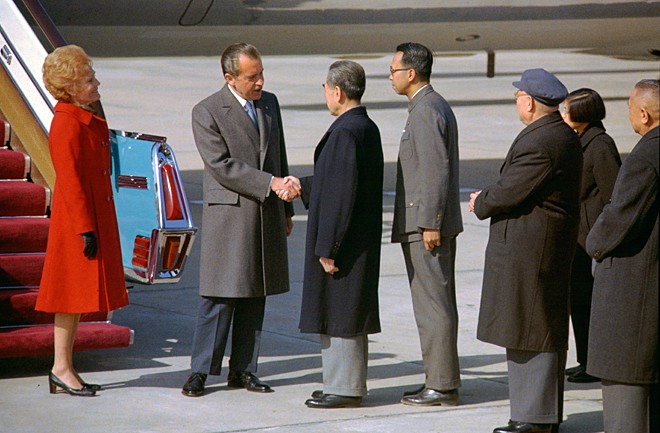by David Parmer
The photo above captures forever the moment when Richard M. Nixon, 37th President of The United States extended his hand to China’s premier, Zhou Enlai. President Nixon called his trip “the week that changed the world” and this handshake was the start of that week.
For more than 20 years the US and the PRC had not been talking. The US backed the Republic of China (ROC) during the bloody civil war following the defeat of Japan. The US had also fought Chinese troops in the Korean War. So, in short, there was no love lost. Americans were imperialists and the PRC were “Red Chinese.” What’s more, during his long political career, Richard Nixon had made no secret of his strong anti-communist convictions.
Later, some said that, precisely because of those anti-communist credentials, only Nixon could have made this gesture and this trip. While Mr. Nixon spoke of making a safer world and a world of peace during the public ceremony in Washington before his departure on February 17th, deeper political realities were underneath, particularly an attempt to gain leverage on the Soviet Union by making peace with the PRC. Some commentators suggest that the US also hoped to get some leverage on the North Vietnamese with the aid of Chinese help.
China itself had had border disputes with it colossal neighbor to the north, and just a few years before had engaged in a drawn-out shooting incident along their Ussuri River border. So perhaps both the US and China saw some tactical advantages in their relations with the Soviets in addition to other hoped-for benefits.
No sooner had Nixon and his party arrived at their guesthouse on that February day than Chairman Mao sent Premier Zhou to tell the president that the chairman would see them. Now. Mr. Nixon, Henry Kissinger, Winston Lord and one Secret Service agent motored over to see the chairman for a two-hour meeting. (The minutes of the meeting as taken by Mr. Lord can be read here.) Nixon and Mao had a frank discussion, but Mao was in turn philosophical, jovial and obscure. The aging and frail Mao had made his point, and now it was up to Premier Zhou to work out the details (and keep Chairman Mao updated on the proceedings.)
In the week that followed there were predictably speeches and toasts and meetings and sightseeing for the Nixons and their party. They went to West Lake in Hangzhou, to the Beijing Zoo, and to the Great Wall outside of Beijing. At the Great Wall, it was Mr. Nixon who waxed philosophical, giving the opinion that it was a great people who built the Great Wall. He also noted his party had travelled 17,000 miles, to get to China, but he felt that “it was worth coming.”
For the final stop on the trip the president’s party returned to Shanghai, and there, at the Jin Jiang Hotel, the Shanghai Communiqué was written and agreed upon. The document pointed out areas of agreement between the two countries and laid out a roadmap for normalization of relations.
Of particular note was the statement concerning Taiwan that became the “One China Policy.” This could be seen as the second most important outcome of Mr. Nixon’s visit coming very close to the sheer audacity of making the trip at all.
In his closing remarks the president said, “generations will look back and thank us.” It is now 45 years later. Does this generation realize the significance of February 1972, or will more time have to pass before there is clarity on this game-changing event?
Photo: Richard Nixon and Zhou Enlai February 21, 1971. Beijing/Public Domain
 日本語
日本語 English
English 中国語
中国語